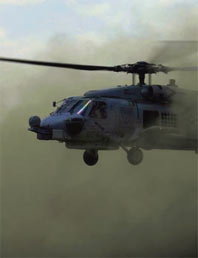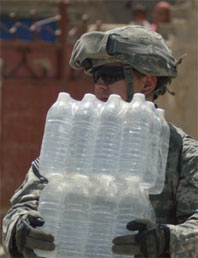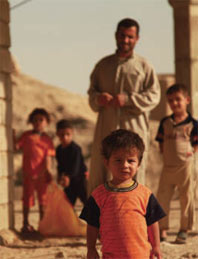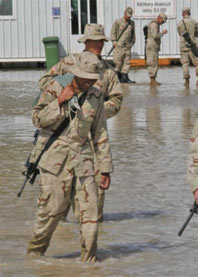National Security and Climate Change
In April 2007, CNA completed a national security implications assessment of global climate change in order to “better inform U.S. policymakers and the public” about effects and potential threats. This non-profit research organization, which operates the Center for Naval Analyses and the Institute for Public Research, convened a Military Advisory Board (MAB) of 3-4 star retired generals and admirals, as well as national security experts, in order to accomplish this task. The MAB and study team received briefings from a wide array of intelligence, climate science and business experts, as well as United Kingdom state leaders. In addition, the well-respected MAB members presented their own views based upon years of hardcore, real world experience. The resultant Report is historic in that it succeeded in painting a bull’s eye on a subject of grave military concern that had heretofore not been adequately addressed by Congress or the then current administration. Although “National Security and the Threat to Climate Change” is 2-years old, the majority of the document remains current and valid as evidenced by MAB members continuing to brief U.S. and international leaders and organizations on its findings. Below are selected excerpts taken directly from the Report found at www.cna.org.

U.S. Air Force photo by
Senior Airman Jacqueline Kabluyen
CLIMATE CHANGE AND THE SCOPE OF THIS STUDY
“Although there is a great deal of agreement among the world’s climate scientists regarding the overall picture of a changing climate, there is also some disagreement about the extent of future changes. . . . Regardless of this continuing discussion, the board’s view is quite clear: The potential consequences of climate change are so significant that the prudent course of action is to begin now to assess how these changes may potentially affect our national security . . .
“This approach shows how a military leader’s perspective often differs from the perspectives of scientists, policymakers or the media. Military leaders see a range of estimates and tend not to see it as a stark disagreement, but as evidence of varying degrees of risk. They don’t see the range of possibilities as justification for inaction. Risk is at the heart of their job: They assess and manage the many risks to America’s security. Climate change, from the Military Advisory Board’s perspective, presents significant risks to America’s national security.”
GEO-STRATEGIC IMPLICATIONS OF CLIMATE CHANGE
“One reason human civilizations have grown and flourished over the last five millennia is that the world’s climate has been relatively stable. However, when climates change significantly or environmental conditions deteriorate to the point that necessary resources are not available, societies can become stressed, sometimes to the point of collapse.”
The Destabilizing Impacts of Climate Change
Reduced Access to Fresh Water “Adequate supplies of fresh water for drinking, irrigation and sanitation are the most basic prerequisites for human habitation. Changes in rainfall, snowfall, snowmelt and glacial melt have significant effects on fresh water supplies, and climate change is likely to affect all of those things. In some areas of the Middle East, tensions over water already exist.
“Forty percent of the world’s population derives at least half of its drinking water from the summer melt of mountain glaciers, but these glaciers are shrinking and some could disappear within decades. . . Most countries in the Middle East and northern Africa are already considered water scarce, and the International Water Resource Management Institute projects that by 2025, Pakistan, South Africa and large parts of India and China will also be water scarce. To put this in perspective: The U.S. would have to suffer a decrease in water supply that produces an 80 percent decrease in per capita water consumption to reach the United Nations’ definition of ‘water scarce.’”

Photo by Sgt. Martin Newton
Impaired Food Production “Access to vital resources . . . can be an additional causative factor of conflicts, a number of which are playing out today in Africa. Probably the best known is the conflict in Darfur between herders and farmers. . . . Probably more than any other recent conflict, Darfur provides a case study of how existing marginal situations can be exacerbated beyond the tipping point by climate-related factors. . . . Worldwide food production will be affected by climate change in a variety of ways. Crop ecologists estimate that for every 1.8°F rise in temperature above historical norms, grain production will drop 10 percent.”
Health Catastrophes “Climate change is likely to have major implications for human health. . . . The major concern is significant spreading of the conditions for vector-borne diseases, such as dengue fever and malaria, and food-borne diseases, such as salmonellosis. The decline in available fresh water in some regions will also have an impact, as good health and adequate supplies of clean water are inextricably linked.”
“I was a total agnostic. I had spent most of my life in the space and aeronautics world and hadn’t really wrestled with the extent to which fossil fuel emissions were affecting the climate. I was open-minded. . . . As I looked at it on my own . . . I was utterly convinced of this connection between the burning of fossil fuels and climate change. And I was convinced that if we didn’t do something about this, we would be in deep trouble.“One of the things that struck me on my first day in space is that there is no blue sky. It’s something that every human lives with on Earth, but when you’re in space, you don’t see it. . . . But when you look at the earth’s horizon, you see an incredibly beautiful, but very, very thin line. You can see a tiny rainbow of color. That thin line is our atmosphere. And the real fragility of our atmosphere is that there’s so little of it.” —- Vice Admiral Richard H. Truly, USN (Ret.), former NASA Administrator, Shuttle Astronaut and the first Commander of the Naval Space Command.

U.S. Army photo by Spc. Canaan Radcliffe
Land Loss and Flooding: Displacement of Major Populations “About two-thirds of the world’s population lives near the coastlines, where critically important facilities and infrastructure, such as transportation routes, industrial facilities, port facilities and energy production and distribution facilities are located. A rise in sea level means potential loss of land and displacement of large numbers of people. Even in our own nation, Hurricane Katrina showed the social upheaval and tensions that can result from land loss and displaced populations.
“Storm surges will also take a greater toll on coastal communities and infrastructure as sea levels rise. According to a Pacific Institute study, a 6-inch rise in the water level of San Francisco Bay would mean a fairly routine one-in-ten-year storm would wreak as much damage as a far more serious ‘hundred-year storm’ would have caused before sea level rise. . . As sea levels rise and storm surges increase, saline water can contaminate groundwater, inundate river deltas and valleys and destroy croplands.”
Security Consequences of these Destabilizing Effects
Greater Potential for Failed States and the Growth of Terrorism “Many developing countries do not have the government or social infrastructures in place to cope with the types of stressors that could be brought on by global climate change. When a government can no longer deliver services to its people, ensure domestic order and protect the nation’s borders from invasion, conditions are ripe for turmoil, extremism and terrorism to fill the vacuum.”
Mass Migrations Add to Global Tensions “. . . when water or food supplies shift or when conditions otherwise deteriorate (as from sea level rise, for example), people will likely move to find more favorable conditions. Although climate change may force migrations of workers due to economic conditions, the greatest concern will be movement of asylum seekers and refugees who, due to ecological devastation, become settlers.
- By 2025, 40 percent of the world’s population will be living in countries experiencing significant water shortages.
- Over the course of this century, sea level rise could potentially cause the displacement of tens of millions of people from low-lying areas such as Bangladesh.”
Potential Escalation of Conflicts over Resources “To live in stability, human societies need access to certain fundamental resources, the most important of which are food and water. The lack, or mismanagement, of these resources can undercut the stability of local populations; it can affect regions on a national or international scale. . . . Resource scarcity always has the potential to be a contributing factor to conflict and instability in areas with weak and weakly supported governments.”
THE WESTERN HEMISPHERE
Risks for the United States
“The primary security threats to the U.S. arise from the potential demand for humanitarian aid and a likely increase in immigration from neighbor states. It is important to remember that the U.S. will be dealing with its own climate change issues at the same time.”
Increasing Water Scarcity and Glacial Melt “Drought and decreased rainfall is projected to also affect the central southern U.S. . . . The High Plains (or ‘Ogallala’) aquifer . . . provides water for 27 percent of the irrigated land in the country and supplies about 30 percent of the groundwater used for irrigation. In fact, 3 of the top grain-producing states – Texas, Kansas and Nebraska – each get 70-90 percent of their irrigation water from the Ogallala aquifer. Human-induced stresses on this groundwater have resulted in water-table declines greater than 100 feet in some areas. This already difficult situation could be greatly exacerbated by a decrease in rainfall predicted for the region. Similarly, a recent study by the National Research Council on the Colorado River Basin (the river is the main water source for tens of millions of people in the Southwest) predicted substantial decreases in river flow, based on higher population coupled with the climate change affects.”
Storms and Sea Level Rise “Flooding could increase with sea level rise, especially in the low-lying areas of North America. Inundation models from the University of Arizona project that a sea level rise of 3 feet would cause much of Miami, Fort Myers, a large portion of the Everglades and all of the Florida Keys to disappear.”
Increased Migration/Refugee Flows into the U.S. “The rate of immigration from Mexico to the U.S. is likely to rise because the water situation in Mexico is already marginal and could worsen with less rainfall and more droughts. Increases in weather disasters, such as hurricanes elsewhere, will also stimulate migrations to the U.S.”
Weapons Systems and Platforms “Operating equipment in extreme environmental conditions increases maintenance requirements – at considerable cost – and dramatically reduces the service life of the equipment. . . . climate change – whether hotter, drier or wetter – will add stress to our weapons systems. . . . A stormier northern Atlantic would have implications for U.S. naval forces. More storms and rougher seas increase transit times, contribute to equipment fatigue and hamper flight operations.”

Image courtesy www.dvidshub.net
Bases Threatened by Rising Sea Levels “U.S. bases abroad are situated to provide a worldwide presence and maximize our ability to move aircraft and personnel. Climate change could compromise some of those bases. . . . Closer to home, military bases on the eastern coast of the United States are vulnerable to hurricanes and other extreme weather events. In 1992, Hurricane Andrew ravaged Homestead Air Force Base in Florida so much that it never reopened. In 2004 Hurricane Ivan knocked out Naval Air Station Pensacola for almost a year. Increased storm activity or sea level rise caused by future climate change could threaten or destroy essential base infrastructure. If key military bases are degraded, so, too, may be the readiness of our forces.”
DoD Energy Supplies Vulnerable to Extreme Weather “The Department of Defense (DoD) is almost completely dependent on electricity from the national grid to power critical missions at fixed installations and on petroleum to sustain combat training and operations. Both sources of energy and their distribution systems are susceptible to damage from extreme weather. . . . ”
Engagement Opportunities “If the frequency of natural disasters increases with climate change, future military and political leaders may face hard choices about where and when to engage. Deploying troops affects readiness elsewhere; choosing not to may affect alliances. And providing aid in the aftermath of a catastrophic event or natural disaster can help retain stability in a nation or region, which in turn could head off U.S. military engagement in that region at a later date.”
FINDINGS AND RECOMMENDATIONS
Findings
1.) Projected climate change poses a serious threat to America’s national security. 2.) Climate change acts as a threat multiplier for instability in some of the most volatile regions of the world. 3.) Projected climate change will add to tensions even in stable regions of the world. 4.) Climate change, national security and energy dependence are a related set of global challenges.
Recommendations
1.) The national security consequences of climate change should be fully integrated into national security and national defense strategies. 2.) The U.S. should commit to a stronger national and international role to help stabilize climate changes at levels that will avoid significant disruption to global security and stability. 3.) The U.S. should commit to global partnerships that help less developed nations build the capacity and resiliency to better manage climate impacts. 4.) The DoD should enhance its operational capacity by accelerating the adoption of improved business processes and innovative technologies that result in improved U.S. combat power through energy efficiency. 5.) The DoD should conduct an assessment of the impact on U.S. military installations worldwide of rising sea levels, extreme weather events and other possible climate change impacts over the next 30-40 years.

U.S. Marine Corps photo by Cpl. Randall A. Clinton
Note: According to David Catarious, Ph.D. and CNA senior researcher, within the 2 years since the Report has been published “none of the things that we said have been proven to be untrue or off the mark, except for the fact that climate change impacts have moved quicker than what we had anticipated based on the original data. Most of the scientists and their models predicted some sort of an anomaly happening in the 2030s wherein the Arctic Ocean ice cover would decrease significantly and dramatically and, thereafter, be at a permanently decreased state. For one reason or another, that anomaly has already begun to occur. The Arctic is changing about three decades ahead of schedule.
“I’m not sure people have fully realized the implications of climate change. I think they intellectualize but don’t really understand what it means. That’s why CNA is doing more work on this to figure out what the impacts are, such as agriculture in Africa decreasing by 40-50 percent by the middle of this century,” said Catarious.
The researcher continued to explain that one of the problems is that Americans have yet to experience these impacts as per the rest of the world, such as in Europe where mass migrations of Africans into Spain, France and Italy are already occurring. Another example is the 2003 heat wave in France and Western Europe, which killed, conservatively, 35,000 people. Catarious cautioned that Naval Research Laboratory experts have predicted that similar events will happen around the world every 3-to-5 years by mid-century. As U.S precipitation begins to decrease, particularly in the Southwest, U.S. temperatures will continue to increase.
“It’s going to hit us in a way that we’re not prepared for,” explained Catarious.





























